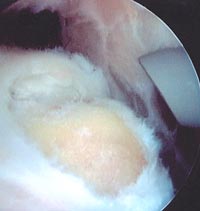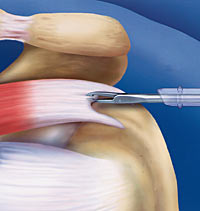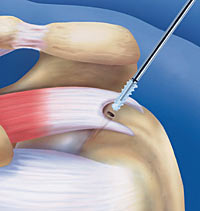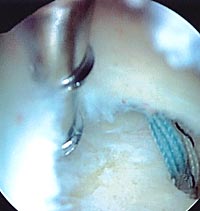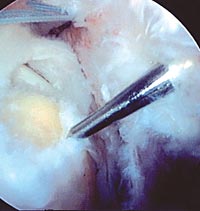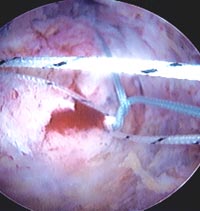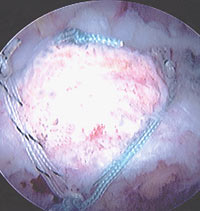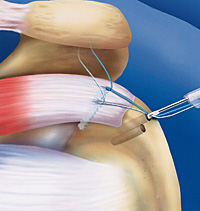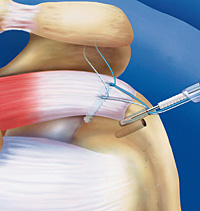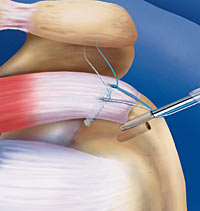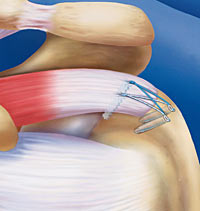Arthroscopic double-row rotator cuff repair designed to enhance healing
The persistent tear rates after open and arthroscopic rotator cuff repair have stimulated development of improved repair techniques to enhance tendon healing.
Arthroscopic repair techniques currently emphasize the following:
(1) proper recognition of tear pattern;
(2) adequate mobilization of retracted tendons;
(3) restoration of the native insertional footprint; and
(4) adequate repair strength.
The most recent advances employ mechanical fixation that enhances the biology of healing by compressing the tendon against the intended repair site.
The following is a description of the most current techniques in arthroscopic double-row rotator cuff repair that provide optimal restoration of the insertional footprint, repair strength and compression of the tendon against the greater tuberosity.
Technique
We create a standard posterior portal and perform glenohumeral diagnostic arthroscopy with appropriate intra-articular procedures. We then introduce a camera into the subacromial space and create a lateral working portal 2 cm lateral to the mid-anterior acromion.
Next, we perform a bursectomy and identify the tear pattern. Mobilization techniques are performed as necessary, including an anterior interval slide, posterior interval slide and capsular releases. A double-row repair requires adequate lateral mobilization of the tendon so that the tendon covers the entire the footprint in the lateral direction.
The greater tuberosity footprint is debrided with removal of soft tissue and the cortical bone is abraded to stimulate healing. Fig. 1 demonstrates a typical crescent-shaped tear of the supraspinatus. Fig. 2 illustrates a soft tissue grasper being used to assess lateral mobility of the tear.
|
|
|
|
|
|
|
|
Medial row
The repair sequence involves placing a medial row of suture anchors with sutures through the tendon in a mattress fashion. The medial row anchors are positioned as medially as possible, adjacent to the articular surface of the humeral head. For a typical crescent-shaped supraspinatous tear as shown in Fig. 1, two anchors are placed in the anterior and posterior thirds of the footprint (Fig. 3). For larger tears (Fig. 4), more anchors are placed as needed. In such cases, suture anchors that are double-loaded with two sutures are preferred. We then perform suture passing, creating medial mattress suture configurations that are ideally 10 mm to 12 mm medial to the lateral edge of the rotator cuff tear (Fig. 5). This maximizes the lateral tendon available for compression against the footprint.
Both limbs of the second suture from each anchor are passed through the tendon just medial to the horizontal mattress sutures. We then tie knots for the horizontal mattress sutures, which reduces and fixes the tendon to the medial aspect of the footprint.
Next, we place the lateral row of suture anchors, using one or two lateral sutures according to the size of the footprint repair site. The anchors are placed lateral to the lateral edge of the footprint to fully maximize the tendon-to-footprint contact (see Figs. 5 and 6). One limb from the free medial sutures is then shuttled through the eyelet of the lateral anchor. We do this by retrieving a suture from the lateral anchor and the medial anchor outside the lateral cannulae.
We sew the suture from the medial anchor through the lateral suture with a free needle. Next, we pull the lateral suture through the lateral anchor eyelet, thereby shuttling the medial suture. A second suture may be shuttled through each anchor to create a cruciate-type compression suture bridge to enhance the compression (Fig. 7). After the sutures are shuttled, we tie a knot (Fig. 8).
In recent years, product developers have introduced new implant devices to greater facilitate placement of compression sutures and eliminate knot tying. For the Push Lock device (Arthrex), we attach the medial suture anchors and pass the suture as previously described.
We place a drill hole at the intended site for the lateral anchor just next to the lateral edge of the tuberosity. The medial sutures intended for compression are then passed through the eyelet of the implant inserter outside the cannulae (Fig. 9). We then apply tension to the compression sutures as they are delivered into the tunnel to achieve the desired compression force (Fig. 10).
The implant is then advanced over the inserter, which fixes the sutures in place (Fig. 11). We can also create cruciate suture configurations to further enhance the repair (Fig. 12).
|
|
|
|
|
|
|
|
Biomechanical results
We have shown in several laboratory studies that transosseous tunnels create compression of the tendon across the insertional footprint and reduce tendon motion relative to the footprint with humeral rotation. This has led to the new generation of repair techniques that are “transosseous-equivalent.”
Unpublished data have also shown that the newly described “transosseous-equivalent” footprint-restoring rotator cuff repairs provide improved footprint contact area and mean footprint pressure when compared to standard double-row techniques.
Christopher S. Ahmad, MD, is assistant professor of orthopedic surgery at the Center for Shoulder, Elbow and Sports Medicine, Columbia University, New York.
For more information:
- Ahmad CS, Stewart AM, Izquierdo R, Bigliani LU. Comparison of tendon bone interface motion for suture anchor and transosseous suture cuff repairs. Am J Sports Med. 2005;33:1667-1671.
- Park, M. C.; Cadet, E. R.; Levine, W. N.; Bigliani, L. U.; and Ahmad, C. S.: Tendon-to-bone pressure distributions at a repaired rotator cuff footprint using transosseous suture and suture anchor fixation techniques. Am J Sports Med.2005;33(8):1154-9.

